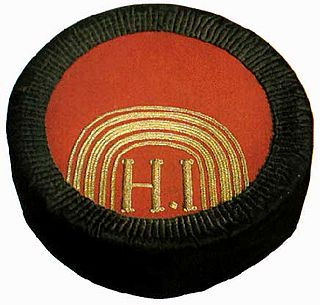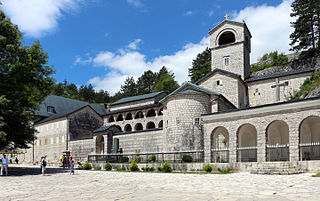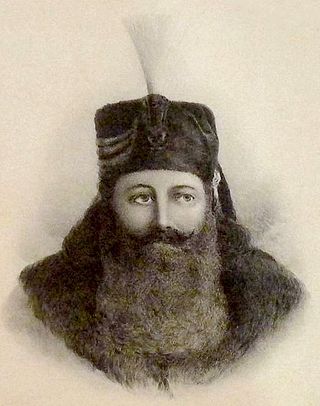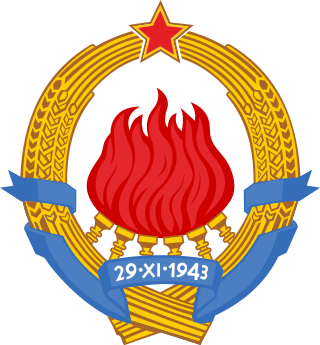Montenegro
- Coat of arms of Montenegro
- State Seal of Montenegro
- Coat of arms of Montenegrin Armed Forces
This is a list of coats of arms of Montenegro. Most municipalities of Montenegro have their own coat of arms. Many Montenegrin military units and other public agencies and some private families have coats of arms. There are also many historical Montenegrin coat of arms throughout history. [1] [2]
The early written records of the history of Montenegro begin with Illyria and its various kingdoms until the Roman Republic incorporated the region into the province of Illyricum after the Illyro-Roman Wars.

Cetinje is a town in Montenegro. It is the former royal capital of Montenegro and is the location of several national institutions, including the official residence of the president of Montenegro. According to the 2023 census, the town had a population of 12,460 while the Cetinje Municipality had 14,465 residents. Cetinje is the centre of Cetinje Municipality. The city rests on a small karst plain surrounded by limestone mountains, including Mount Lovćen, the legendary mountain in Montenegrin historiography. Cetinje was founded in the 15th century and became a cradle of the culture of Montenegro. Its status as the honorary capital of Montenegro is due to its heritage as a long-serving former capital of Montenegro.

The national flag of Montenegro has a red field with gold border and the coat of arms of Montenegro in its center. It was officially adopted on 13 July 2004, when the then Republic of Montenegro was a constituent of the State Union of Serbia and Montenegro, and its precise specification was standardized on 16 September 2004. The flag was retained after Montenegrin independence from Serbia in 2006, and mandated by Article 4 of the Constitution of Montenegro adopted in 2007.

Danilo I Petrović-Njegoš was the ruling Prince of Montenegro from 1851 to 1860. The beginning of his reign marked the transition of Montenegro from a traditional theocratic form of government (Prince-Bishopric) into a secular Principality.

Nicholas, Prince of Montenegro is a French-born architect and the Head of the House of Petrović-Njegoš, which reigned over Montenegro from 1696 to 1766 and again from 1782 to 1918.
Onamo 'namo! is a patriotic song written by Prince Nicholas of Montenegro and first published in the Novi Sad-based Serbian-language literary journal Danica in 1867. Its melody can be attributed either to the Slovene composer Davorin Jenko or the Czech chaplain František Wimmer, the conductor of the Royal Montenegrin Army's military band.

A cross pattée, cross patty or Pate, or cross paty, also known as a cross formy or cross formée or Templar cross, is a type of Christian cross with arms that are narrow at the centre, and often flared in a curve or straight line shape, to be broader at the perimeter. The form appears very early in medieval art, for example in a metalwork treasure binding given to Monza Cathedral by Lombard queen Theodelinda, and the 8th-century lower cover of the Lindau Gospels in the Morgan Library. An early English example from the start of the age of heraldry proper is found in the arms of Baron Berkeley.

The Montenegrin cap is a cap traditionally worn in Montenegro by the Montenegrins and Serbs of Montenegro. It was introduced by Prince Bishop Petar II Petrović-Njegoš in the mid-1840s as a replacement for the then-popular fez.

The coat of arms of Serbia and Montenegro consisted of a shield with the Serbian eagle and the shield with a quartering the Serbian cross and the Montenegrin lion of Saint Mark. This emblem had served as the national symbol of the State Union of Serbia and Montenegro.

The coat of arms of Montenegro was officially adopted by the law passed in the Parliament on 12 July 2004. It is now the central motif of the flag of Montenegro, as well as the coat of arms of the Armed Forces of Montenegro. It was constitutionally sanctioned by the Constitution proclaimed on 2 October 2007.

The House of Petrović-Njegoš is the family that ruled Montenegro from 1697 to 1918.

The Metropolitanate of Montenegro and the Littoral of the Serbian Orthodox Church is the largest eparchy (diocese) of the Serbian Orthodox Church in modern Montenegro. Founded in 1219 by Saint Sava as the Eparchy of Zeta, it has continued to exist, without interruption, up to the present time, and has remained one of the most prominent dioceses of the Serbian Orthodox Church. The current Metropolitan bishop is Joanikije II. His official title is "Metropolitan of Montenegro and the Littoral".

Vasilije Petrović was the metropolitan bishop of Cetinje, ruling with Sava Petrović, his cousin. He was author of the History of Montenegro, published in 1754.

The current Constitution of Montenegro was ratified and adopted by the Constitutional Parliament of Montenegro on 19 October 2007 in an extraordinary session by achieving the required two-thirds supermajority of votes. It was officially proclaimed on 22 October 2007, replacing the constitution of 1992.

Veljko Milatović was a Montenegrin Communist partisan, politician, statesman serving once as the Speaker and twice as President.

The Montenegrin passport is the primary document for international travel issued by Montenegro.

The Emblem of Yugoslavia featured six torches, surrounded by wheat with a red star at its top, and burning together in one flame; this represented the brotherhood and unity of the six federal republics forming Yugoslavia: Bosnia and Herzegovina, Croatia, Macedonia, Montenegro, Serbia and Slovenia. The date imprinted was 29 November 1943, the day the Anti-Fascist Council for the National Liberation of Yugoslavia (AVNOJ) met in Jajce on its second meeting and formed the basis for post-war organisation of the country, establishing a federal republic. This day was celebrated as Republic Day after the establishment of the republic. The emblem of Yugoslavia, along with those of its constituent republics, are an example of socialist heraldry.

The Prince-Bishopric of Montenegro was a Serbian Orthodox ecclesiastical principality that existed from 1516 until 1852. The principality was located around modern-day Montenegro. It emerged from the Eparchy of Cetinje, later known as the Metropolitanate of Montenegro and the Littoral, whose bishops defied the Ottoman Empire overlordship and transformed the parish of Cetinje into a de facto theocracy, ruling it as Metropolitans.
Capital punishment in Montenegro was first prescribed by law in 1798. It was abolished on 19 June 2002. The last execution, by shooting, took place on 29 January 1981, and the two last death sentences were pronounced on 11 October 2001. Montenegro is bound by the following international conventions prohibiting capital punishment : Second Optional Protocol to the International Covenant on Civil and Political Rights, as well as Protocols No. 6 and No. 13 to the European Convention on Human Rights. Article 26 of the Montenegrin Constitution (2007) that outlawed the death penalty states: "In Montenegro, capital punishment punishment is forbidden”.
Brda refers to a historical and ethnographical region in Montenegro. The Brda are one of the country's four historic tribal regions, along with Old Montenegro, Old Herzegovina and the Montenegrin Littoral. The historical tribes of the Brda are the Vasojevići, the Bjelopavlići, the Piperi, the Kuči, the Bratonožići, the Moračani and the Rovčani. Collectively known as "the seven tribes" or "the seven hills", they were referred to as "Highlander tribes" before their gradual integration into Montenegro, from the late 18th to the early 20th century. As a result, members of these tribes are also often called "Highlanders".